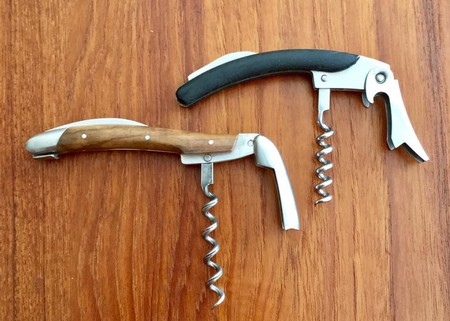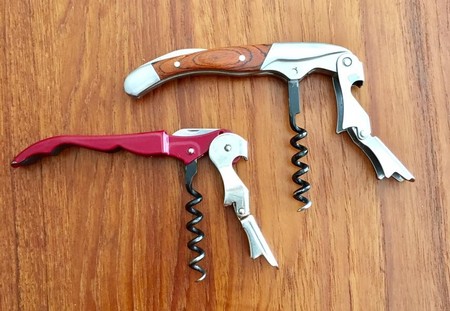Thoughts on Using a Waiter’s Corkscrew
A recent question and series of replies on Facebook prompted me to write about the use of a standard waiter’s corkscrew when opening a wine. The question that was asked related to whether users tended to pull the cork out of the bottle with the hand on top of the corkscrew handle, versus lifting the cork out with the hand underneath the corkscrew handle. I have a fairly strong opinion on this matter, but there are extenuating circumstances that should be addressed before making a final pronouncement.
Most waiter’s corkscrews fall into one of two categories – either 1) a single hinged, one-lip tab or 2) a double hinged, two lip tab. These types are illustrated in the photos below. The primary objective when using either of these types of corkscrews is to remove the cork from the bottle while keeping it as vertical as possible with no (or very little) damage to the cork. The comments that follow result from over 40 years of personal experience opening thousands of bottles of wine and helping hundreds of servers learn the proper techniques.

1.) Waiter’s Corkscrews with a single hinged, one-lip tab
Using a type #1 corkscrew (shown in photo #1) typically requires the use of more force to remove the cork via either multiple pull strokes, or one longer pull stroke. One approach to using a #1 type corkscrew is to insert the screw only about one-third of the way into the cork, then leverage the single lip tab against the top lip of the bottle, and pull the cork just a short ways upward. Release the tab, insert the screw another one-third of the way into the cork, and repeat with another upward pull of the cork. Finally, insert the screw fully into the cork, leverage the single lip tab onto the top lip of the bottle for final cork removal. This can be a bit more time-consuming, but accomplishes two key objectives – uses the corkscrew to its best mechanical advantage and helps prevent breakage of the cork, especially one from an older bottle of wine. (Cork breakage most often occurs when the top of the cork is dry and the bottom is wet, so when bending stress is applied to the cork, it breaks at the junction between wet and dry.)
If one does the above operation with the hand on top of the corkscrew handle, it is likely to work more smoothly and with less chance to damage the cork, or the screw. Placing the hand under the corkscrew handle and lifting the cork tends to result in bending the cork as it comes out of the bottle and putting significant bending stress on the screw. The wooden handled, hand-made French Lagioule corkscrew shown in photo #1 was damaged when someone removed a long cork using the upward lift approach and pushed the corkscrew back almost 180 degrees by the time the cork came out of the bottle. The screw on this lovely device was permanently bent, and the overall experience was, for me, a real downer. I have never allowed anyone else to use one of my more valuable corkscrews since that time.
Now, there are reasons that one may need to resort to the upward lift approach when using a corkscrew. If hand-strength is limited, or if one is vertically challenged and finds it difficult to place the hand on top of the corkscrew handle and apply leverage, then the upward lift may be required. If so, follow the stepwise technique described above, and remember to lift the cork from the bottle keeping it as vertical as possible. This will require less effort for opening, and prevent damage to the corkscrew and cork.

2.) Waiter’s corkscrews with a double hinged, two lip tab
A wonderful option for opening wine bottles is a waiter’s corkscrew with a double hinged, two lip tab as shown in photo #2. The one with red plastic handle has served me well for several years opening thousands of bottles easily and without incident. Insert the screw about 60% into the cork, rest the first, shorter tab lip onto the top lip of the bottle, and pull the cork about ½ in to ¾ in out of the bottle. Unhinge the corkscrew and re-set the second, longer tab onto the top lip of the bottle and finish pulling the cork out. This simple and quick procedure seems to work best by pulling the cork vertically upwards with your hand on top of the handle, but, if necessary, will work by lifting the cork with your hand under the handle.
Now, my strong preference is to place your hand on top of the corkscrew handle and pull the cork from the bottle. The double hinged, two lip tab corkscrews shown in photo #2 work extremely well with this procedure. Practice opening wine bottles and you can become quite proficient. If need be, collect some corks from your favorite tasting room, fill an empty wine bottle with water, and stuff one of those corks into the bottle. Use the corkscrew of your choice to pull the cork - then do it again and again. With enough practice, almost everyone can become a “pro” at opening wine with a waiter’s corkscrew.
